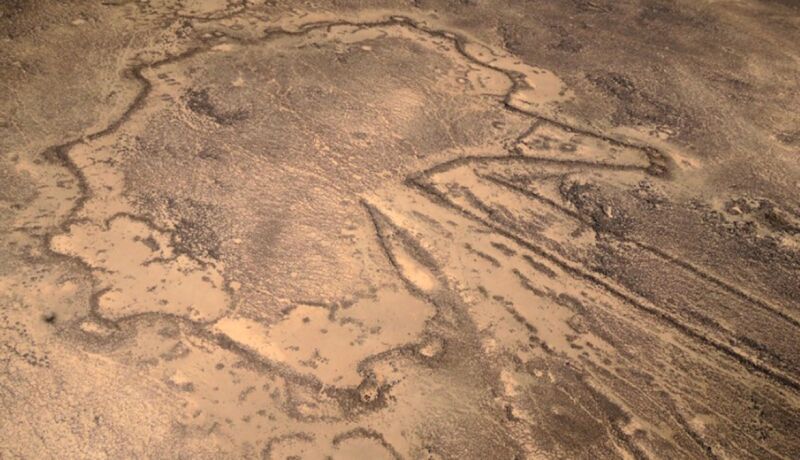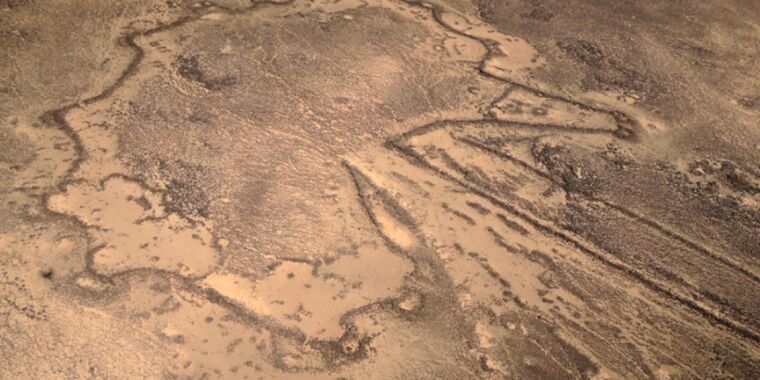
There’s not often time to write down about each cool science-y story that comes our method. So this 12 months, we’re as soon as once more operating a particular Twelve Days of Christmas collection of posts, highlighting one science story that fell by the cracks in 2020, every day from December 25 by January 5. At this time: Archaeologists discovered two stone engravings in Jordan and Saudi Arabia which will characterize the oldest architectural plans for desert kites.
In the course of the Twenties, aerial pictures revealed the presence of enormous kite-shaped stone wall mega-structures in deserts in Asia and the Center East that almost all archaeologists imagine had been used to herd and lure wild animals. Greater than 6,000 of those “desert kites” have been recognized as of 2018, though only a few have been excavated. Archaeologists discovered two stone engravings—one in Jordan, the opposite in Saudi Arabia—that they imagine characterize the oldest architectural plans for these desert kites, in accordance with a Might paper printed within the journal PLoS ONE.
“The invention of those very historic representations highlights the query of the strategies utilized by kite builders,” the authors wrote. “Kites are massive materials buildings that would not be designed with out what we name at the moment planning. The flexibility to transpose massive areas right into a small two-dimensional floor represents a milestone in clever habits. Such buildings are seen as an entire solely from the air, but this requires the illustration of area in a method not seen right now.”
The eight kites at Jibal al-Khashabiyeh in Jordan had been found in 2013, and archaeologists started excavations in 2015 and 2016. Looters had focused one such website, so archaeologists carried out a rescue excavation, noting quite a few carved cigar-shaped limestones scattered across the floor. One such stone had a really well-preserved engraving. The engraving’s form is attribute of the 2 desert kites at Jibal al-Khashabiyeh which might be nearest to the place the engraved rock was discovered, and the authors estimate the age of the engraving to be about 7,000 years outdated.
The engraving was doubtless carved with a lithic instrument, using a mix of tremendous incisions to mark out the contours of the kite and pecking. The kite-shaped engraving includes two main converging curved strains, which the researchers interpreted as representing driving strains. These result in a carved star-shaped enclosure with eight round cup marks on the circumference representing pit traps. The traits are typical of desert kite buildings in southeastern Jordanian kites. The archaeologists stay puzzled by a zigzagging chevron sample operating perpendicular to the hall, however hypothesize that it’d characterize a slope break characteristic.
The kites at Jebel az-Zilliyat in Saudi Arabia had been found in 2014 and excavated the next 12 months. The engraved sandstone boulder on this case—discovered throughout rock artwork surveys—was studied in situ and dated to round 8,000 years in the past. The carving was doubtless made by pecking the contours utilizing a lithic instrument or a handpick. Whereas the japanese engraving on the boulder was very readable, the western one had been badly broken by erosion. Each characteristic the identical two quick, extensively spaced driving strains that progressively converge right into a star-shaped enclosed floor surrounded by six cup marks (pit traps). As soon as once more, the authors famous clear similarities between the engraved representations of kites on the boulder and precise desert kite shapes close by.
There have been different maps, plans, or representations in human historical past, per the authors, akin to Higher Paleolithic engravings in Europe that appear to be maps of looking methods, or a mural in Turkey from about 6600 BCE that appears to depict a village. There may be even a reed-bundle boat present in Kuwait, dated 5000 BCE, that’s thought of to be the oldest three-dimensional mannequin of a large-scale object. Nonetheless, the 2 engravings present in Jordan and Saudi Arabia are distinctive as a result of they had been carried out to scale: roughly 1:425 and 1:175, respectively.
As for why the engravings had been made, the authors thought of three hypotheses: it was an in depth kite building plan; it was a plan for making ready looking actions; or it could possibly be extra symbolic—a method of passing on data of the tempo and/or its perform. Of these, the authors contemplate the second to be essentially the most credible, given the cautious graphical illustration of the purposeful parts of the lure, however can not rule out the opposite two prospects.
“A map would most likely be used right here as a method of communication (nearly like an ancestral method of writing) and would allow the collective interplay required for the graceful operating of looking operations,” the authors concluded. “These two main improvements, i.e., constructing what would change into the most important buildings in human historical past at the moment and making cartographic representations to scale, are intently linked by a standard level: mastering the three-dimensional notion of an area, and translating it into an inscribed type of communication.”
PLoS ONE, 2023. DOI: 10.1371/journal.pone.0277927 (About DOIs).

